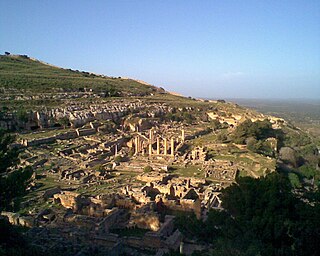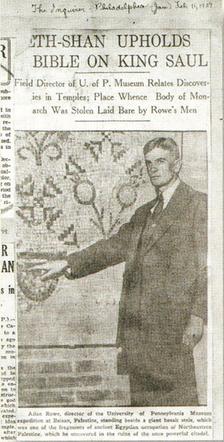
Dame Kathleen Mary Kenyon, was a British archaeologist of Neolithic culture in the Fertile Crescent. She led excavations of Tell es-Sultan, the site of ancient Jericho, from 1952 to 1958, and has been called one of the most influential archaeologists of the 20th century. She was Principal of St Hugh's College, Oxford, from 1962 to 1973, having undertaken her own studies at Somerville College, Oxford.

Leptis or Lepcis Magna, also known by other names in antiquity, was a prominent city of the Carthaginian Empire and Roman Libya at the mouth of the Wadi Lebda in the Mediterranean.

Cyrenaica or Kyrenaika, is the eastern region of Libya. Cyrenaica includes all of the eastern part of Libya between the 16th and 25th meridians east, including the Kufra District. The coastal region, also known as Pentapolis in antiquity, was part of the Roman province of Crete and Cyrenaica, later divided into Libya Pentapolis and Libya Sicca. During the Islamic period, the area came to be known as Barqa, after the city of Barca.

Cyrene or Kyrene was an ancient Greek and later Roman city near present-day Shahhat, Libya. It was the most important of the five Greek cities in the region, known as the pentapolis. It gave eastern Libya the classical name Cyrenaica, which it has retained to modern times.
John Bryan Ward-Perkins, was a British Classical architectural historian and archaeologist, and director of the British School at Rome.

Apollonia in Cyrenaica was founded by Greek colonists and became a significant commercial centre in the southern Mediterranean. It served as the harbour of Cyrene, 20 km (12 mi) to the southwest.

David John Mattingly, FBA is an archaeologist and historian of the Roman world. He is currently Professor of Roman Archaeology at the University of Leicester.
Libya's second largest city, Benghazi, has a history which extends to the present day from when the Greek colony of Euesperides was founded in the 6th century BCE. Throughout its history, the city has been continuously conquered by different ancient and colonial forces.

Gerisa, also called Ghirza, was an ancient city of Roman Libya near the Limes Tripolitanus. It was a small village of 300 inhabitants on the pre-desert zone of Tripolitania.

The area of North Africa which has been known as Libya since 1911 was under Roman domination between 146 BC and 672 AD. The Latin name Libya at the time referred to the continent of Africa in general. What is now coastal Libya was known as Tripolitania and Pentapolis, divided between the Africa province in the west, and Crete and Cyrenaica in the east. In 296 AD, the Emperor Diocletian separated the administration of Crete from Cyrenaica and in the latter formed the new provinces of "Upper Libya" and "Lower Libya", using the term Libya as a political state for the first time in history.
The Laguatan was a Berber clan that inhabited the Cyrenaica area during the Roman period. They have been described as primarily raiders and nomadic, but others consider them a settled group who also raided.

Yoram Tsafrir was an Israeli archaeologist. His research has included the Byzantine influence on ancient synagogues, demography of Palestine in the Byzantine period, mosaics at Horvat Berachot, excavations at Beit She'an, and excavations at Rehoboth. A Professor Emeritus of the Institute of Archaeology at the Hebrew University of Jerusalem, he was a member of the Israel Academy of Sciences and Humanities.

Joyce Maire Reynolds was a British classicist and academic, specialising in Roman historical epigraphy. She was an honorary fellow of Newnham College, Cambridge. She dedicated her life to the study and teaching of Classics and was first woman to be awarded the Kenyon medal by the British Academy. Among Reynolds' most significant publications were texts from the city of Aphrodisias, including letters between Aphrodisian and Roman authorities.
Erythrum was a city and bishopric in Roman Africa, which remains a Catholic titular see.

Alan Jenvey Rowe was a British archaeologist most famous for his studies on ancient Egypt. Rowe was an Egyptologist and lecturer in Near Eastern Archaeology in Manchester University.
Lady Olwen Phillis Frances Brogan was a British archaeologist and expert on Roman Libya. She attended University College London and later taught there. She was the author of two monographs, over thirty articles and was a regular reviewer for Antiquaries Journal, Antiquity and Journal of Roman Studies.
Denys Eyre Lankester Haynes was an English classical scholar, archaeologist, and museum curator, who specialised in the full range of classical archaeology. He was Keeper of Greek and Roman Antiquities at the British Museum between 1956 and 1976. He was additionally Geddes–Harrower Professor of Greek Art and Archaeology at the University of Aberdeen from 1972 to 1973, and, in retirement, visitor to the Ashmolean Museum from 1979 to 1987. He had served in military intelligence during the Second World War.

The Tripolitania Punic inscriptions are a number of Punic language inscriptions found in the region of Tripolitania – specifically its three classical cities of Leptis Magna, Sabratha and Oea (Tripoli), with the vast majority being found in Leptis Magna. The inscriptions have been found in various periods over the last two centuries, and were catalogued by Giorgio Levi Della Vida. A subset of the inscriptions feature in all the major corpuses of Canaanite and Aramaic inscriptions, notably as KAI 119-132.
The British Institute for Libyan and Northern African Studies (BILNAS), formerly the Society for Libyan Studies, is a British academic body and charitable organisation. Sponsored by The British Academy, it promotes scholarship on Libya and Northern Africa in the fields of archaeology, history, geography, the natural sciences and linguistics.
The Temple of Zeus was the largest ancient Greek temple at Cyrene, Libya, and one of the largest Greek temples ever built. The original Doric octastyle peripteral temple was constructed around 500-480 BC, and heavily damaged in 115 AD. Later in the century, it was partially rebuilt as a non-peripteral temple with a colossal cult statue. It was destroyed once more in 365 AD by an earthquake and then burnt by Christians.











